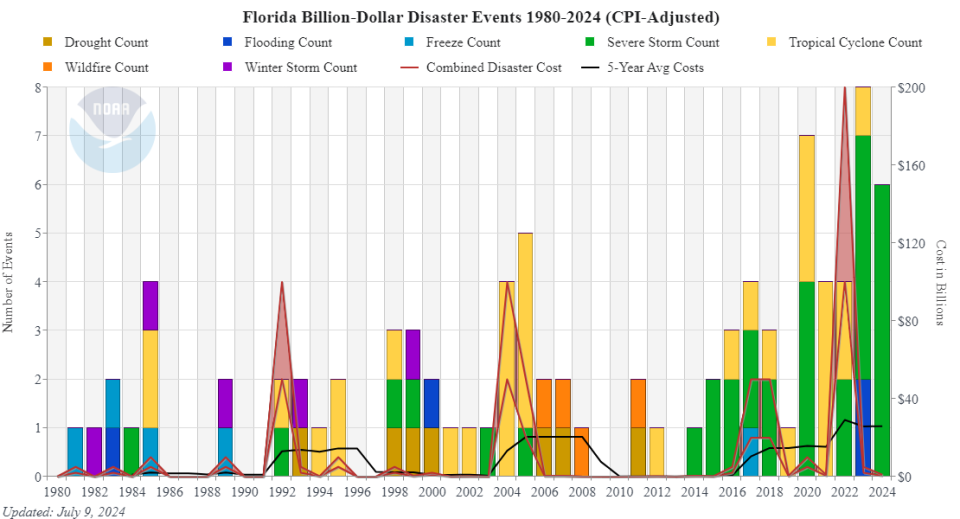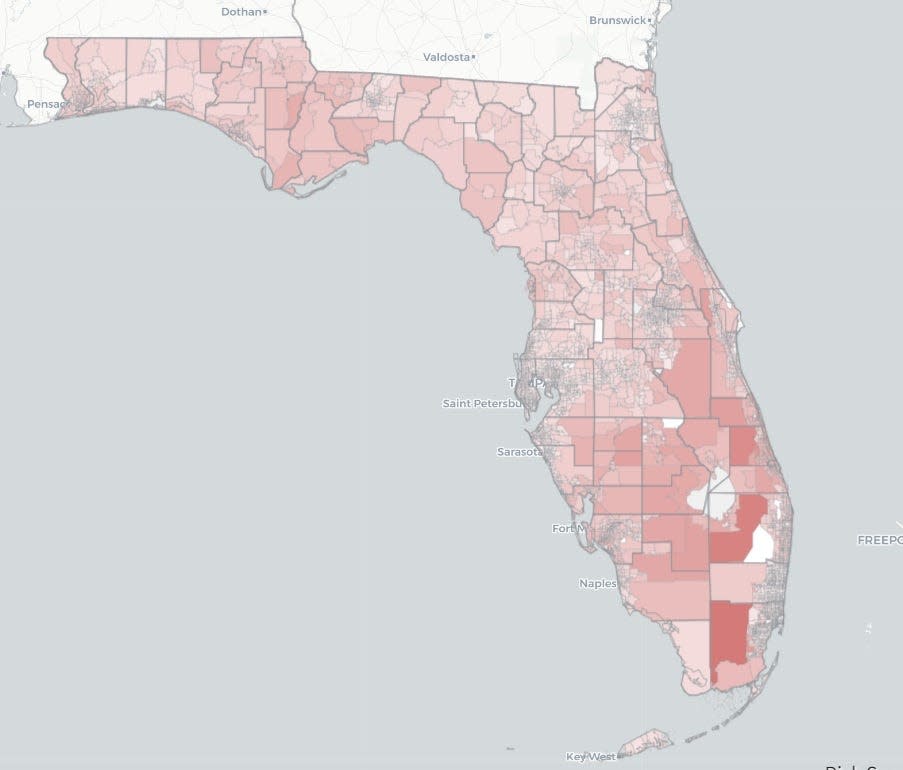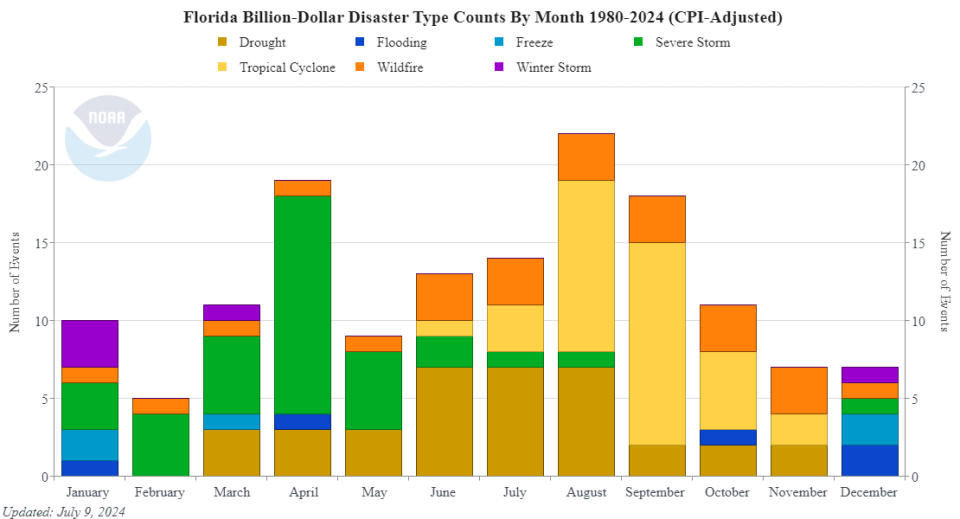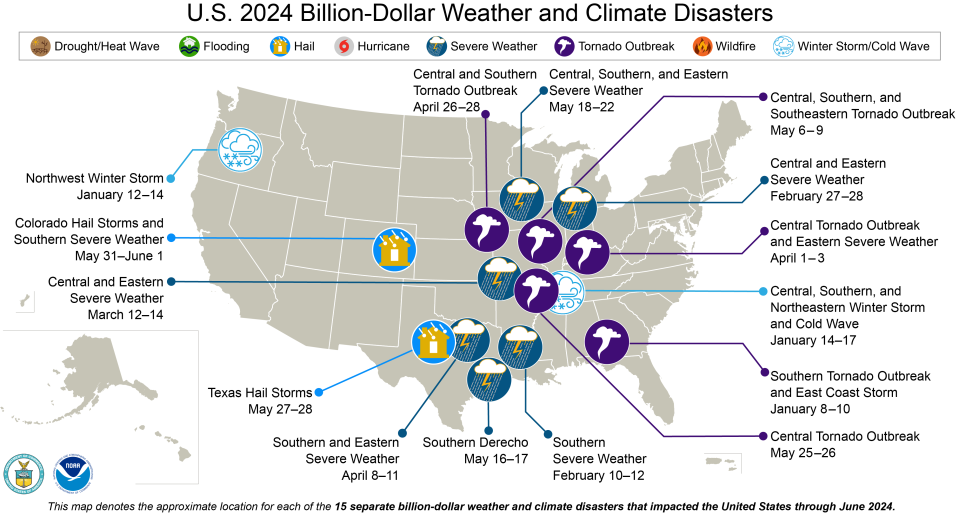Hurricanes are known threat in Florida, but these natural disasters may surprise you
Hurricanes are a recognized threat in Florida, but did you know there are several other natural disasters that impact the state, causing billions of damage?
While we can rule out avalanches, several types of natural disasters are no stranger to the Sunshine State, including drought, freezes and severe storms, which includes tornadoes. From 1980 to 2024, there have been 89 confirmed weather/climate disaster events in Florida reported.
Here's a list of the types of disasters Florida experiences, along with data on the most active months and what you're likely to see in your county.
89 confirmed weather-climate disasters reported in Florida from 1980 to 2024

From 1980 through July 9, 2024, there have been 89 confirmed weather/climate disaster events in Florida, with losses exceeding $1 billion, according to the National Centers for Environmental Information.
Here's the breakdown:
Severe storms: 32
Tropical cyclones: 32
Drought: 7
Flooding: 5
Freeze: 5
Winter storms: 5
Wildfires: 4
See natural disaster risks in your Florida county

Compare the risks for your county with an interactive map from the NCEI. The map breaks down the types of disasters by census tract and compares the numbers with the rest of the county as a whole, Florida and the U.S.
What natural disasters have been confirmed in Florida in 2024?
Here are the natural disasters reported by the National Centers for Environmental Information that have affected Florida this year, as of July 9, 2024:
Southern derecho
Classification: Severe storm
Dates: May 16-May 17, 2024
Estimated cost: $1.2 billion
Deaths: 8
Summary: A rare southern derecho event produced high wind damage from Texas to Florida. Central and eastern Texas were impacted by high winds at times exceeding 100 mph. These winds also ripped through downtown Houston blowing out numerous windows in skyscrapers causing considerable damage. Louisiana, Alabama and Florida also were impacted by damaging winds impacting many homes, vehicles and businesses.
Tornado outbreak
Classification: Severe storm
Dates: May 6-May 9, 2024
Estimated cost: $4.7 billion
Deaths: 3
Summary: An outbreak producing more than 165 tornadoes developed across many central, southern and southeastern states. The states most affected include Oklahoma, Kansas, Nebraska, Michigan, Indiana, Ohio, Kentucky, Tennessee, Alabama, North Carolina, South Carolina, Georgia and Florida. This multi-day tornado outbreak produced at least 61 EF-0, 79 EF-1, 13 EF-2, three EF-3, one EF-4 tornado and dozens of EF-U (unknown/unrated) tornadoes, causing widespread damage to many homes, businesses, vehicles, agriculture and other infrastructure. The towns of Barnsdall and Bartlesville, Oklahoma were impacted by a violet EF-4 tornado that caused extensive damage.
Severe weather
Classification: Severe storm
Dates: April 8-11, 2024
Estimated cost: $2.2 billion
Deaths: 0
Summary: Southern and eastern severe weather produced tornadoes, hail and high wind, from Texas to Virginia. The event began with severe hail and high wind impacts across central and eastern Texas, followed by more than 20 tornadoes impacting the Gulf Coast counties of Louisiana, Mississippi, Alabama and Florida. There were additional high wind and tornado impacts in North Carolina and Virginia.
Tornado outbreak
Classification: Severe storm
Dates: April 1-3, 2024
Estimated cost: $2.5 billion
Deaths: 3
Summary: A central tornado outbreak produced more than 85 tornadoes across a three-day period from Oklahoma to West Virginia. This outbreak included 19 EF-0, 52 EF-1 and 14 EF-2 tornadoes, which were most concentrated across the Ohio River Valley on April 1-2. These tornadoes and severe weather impacts across several eastern states caused damage to homes, businesses, vehicles and other infrastructure.
Severe weather
Classification: Severe storm
Dates: Feb. 10-12, 2024
Estimated cost: $1.1 billion
Deaths: 0
Summary: Severe storms produced up to golf ball sized hail across central and eastern Texas causing damage to homes, vehicles and businesses. Additional damage from hail and high winds and training thunderstorms caused flooding across portions of Louisiana, Alabama, Georgia, Florida and North Carolina.
Tornado outbreak
Classification: Severe storm
Dates: Jan. 8-10, 2024
Estimated cost: $2.8 billion
Deaths: 3
Summary: Southern tornado outbreak and east coast storm impacted more than a dozen states. At least 39 preliminary tornadoes were clustered around the Florida Panhandle through the Carolinas, while hundreds of high wind reports were scattered up the East Coast reflecting damage to homes, businesses, vehicles and other infrastructure. The strongest tornado was an EF-3 that caused significant damage around Panama City Beach, after an intense waterspout moved onshore.
What are the worst months in Florida for natural disasters?

August is the worst month in Florida when it comes to natural disasters, followed by April. Here's the average number of events for each month from 1980 to 2024.
January
Severe storm: 3
Winter storm: 3
Freeze: 2
Flooding: 1
Wildfire: 1
Drought: 0
Tropical cyclone: 0
February
Severe storm: 4
Wildfire: 1
Drought: 0
Flooding: 0
Freeze: 0
Tropical cyclone: 0
Winter storm: 0
March
Severe storm: 5
Drought: 3
Wildfire: 1
Freeze: 1
Winter storm: 1
Tropical cyclone: 0
Flooding: 0
April
Severe storm: 14
Drought: 3
Flooding: 1
Wildfire: 1
Freeze: 0
Tropical cyclone: 0
Winter storm: 0
May
Severe storm: 5
Drought: 3
Wildfire: 1
Flooding: 0
Freeze: 0
Tropical cyclone: 0
Winter storm: 0
June
Drought: 7
Wildfire: 3
Severe storm: 2
Tropical cyclone: 1
Flooding: 0
Freeze: 0
Winter storm: 0
July
Drought: 7
Tropical cyclone: 3
Wildfire: 3
Severe storm: 1
Flooding: 0
Freeze: 0
Winter storm: 0
August
Tropical cyclone: 11
Drought: 7
Wildfire: 3
Severe storm: 1
Flooding: 0
Freeze: 0
Winter storm: 0
September
Tropical cyclone: 13
Drought: 7
Wildfire: 3
Severe storm: 1
Flooding: 0
Freeze: 0
Winter storm: 0
October
Tropical cyclone: 5
Wildfire: 3
Drought: 2
Flooding: 0
Freeze: 0
Severe storm: 0
Winter storm: 0
November
Wildfire: 3
Tropical cyclone: 2
Drought: 2
Flooding: 0
Freeze: 0
Severe storm: 0
Winter storm: 0
December
Flooding: 2
Freeze: 2
Severe storm: 1
Wildfire: 1
Winter storm: 1
Drought: 0
Tropical cyclone: 0
How do Florida natural disasters compare to US totals?
Over the same time period, 1980 to July 9, 2024, there were 391 natural disasters in the U.S. compared to 89 in Florida.
A total of 16,456 people have died from natural disasters in the U.S. over that time period. The total cost of these 391 events exceeds $2.755 trillion.
What areas of US face greatest risk for natural disasters?

"Each geographic region of the U.S. faces a unique combination of weather and climate hazards," according to the National Centers for Environmental Information. "Historically, the U.S. South, Central, and Southeast regions have experienced the highest frequency and highest cost from billion-dollar disaster events.
"During the spring months (March-May) severe storms including tornadoes, hail and high winds often occur in many Central and Southeast states," the NCEI states. "During the spring months there is also potential for major river flooding. U.S. springtime flooding from snowmelt and/or heavy rainfall is a persistent hazard that affects many towns and agriculture regions within the Missouri and Mississippi River basins, among others. During the fall season, Gulf and Atlantic coast states must be vigilant about hurricane season, particularly during August and September."
"The peak of the Western U.S. wildfire season occurs during the fall months of September, October and November. California, Oregon and Washington are often states that face wildfire risk and related poor air quality for weeks to months."
This article originally appeared on Treasure Coast Newspapers: Florida natural disasters: See risk by county, most dangerous month

